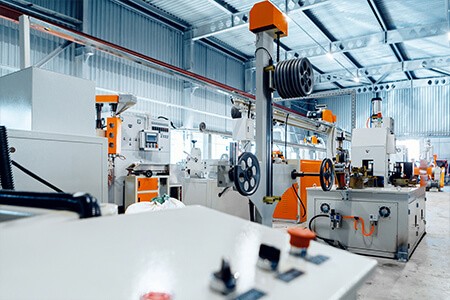Modern configuration software enables the trend towards “customized mass production” to be pursued in a targeted manner. Product configuration as an interface between sales and value-adding functions such as production creates new potential and, thanks to increased flexibility and precise resource planning, fully supports the increasingly dynamic market environment of manufacturing companies. Configuration is the common thread running through the entire process.
Lean manufacturing aims for resource efficiency and flexible production
In the production of goods, lean manufacturing aims to reduce waste within the entire process chain. This involves streamlining the process flow as early as the planning stage in order to maximize flexibility and response time.
In short: lean manufacturing gurantees that the right things are in the right place at the right time in the right quantity. All of these concepts must be understood, appreciated, and embraced by the people who make the products and execute processes. Lean manufacturing seeks to make work simple enough to understand, execute, and manage.
The main principles of lean manufacturing are minimum waiting times, minimum inventories, pull rather than push activities for customer requests, reduced batch sizes, and shorter process times. Reduced batch sizes in particular receive maximum support through product configuration.
Manufacturing principles in brief overview and the applicability of lean manufacturing principles
In practice, the main principles of lean manufacturing cannot always be implemented 100 percent. Sales planning, resource planning, and customer requirements must be carefully balanced in an increasingly customized manufacturing environment. The basis for this is exact data, which ideally should also be available to all process participants at all times.
1. Make-to-Stock (MTS):
This refers to a customized product or catalog product that is manufactured based on a forecast before expected or committed orders are received.
The accuracy of forecasts is critical because they have a direct impact on inventory management and carry the risk of overstocking and associated costs, as well as customer dissatisfaction in the event of delivery delays in the event of understocking. For sensitive products, the maximum storage period adds complexity.
MTS can be considered as push production. MTS is required to prevent opportunity losses due to inventory shortages and minimize excess inventory through accurate forecasting. In the industrialized environment of mass production, this forecast production pushes for standardization and efficient management, such as cost reduction.
2. Make-to-Order (MTO):
These are products that are not in stock and are manufactured after receiving a binding order.
The forms of MTO vary, e.g., an assembly process begins when the need actually occurs, or manufacturing begins with development planning.
Manufacturing upon receiving customer orders means that a pull supply chain operation is started, as manufacturing is performed when demand is confirmed, i.e. pulled from demand. The opposite business model is manufacturing for stock MTS (make to stock), i.e., push manufacturing. There are other refined variations of MTO.
3. Assemble-to-Order (ATO):
A product where some components are kept in stock and the finished product is completed after the order is received.
4. Configure-to-Order (CTO):
The standard product has variants – so many that it is not justified to create a part number for each variant, but also not so many that the underlying structure becomes too complex to handle.
5. Engineer-to-Order (ETO):
Complex structures and customized projects that have never been produced before and make it impossible to work with standard variants.
The evolution of ERP systems
Traditional ERP is a hierarchical system that works from the top down, starting with strategic planning (sales planning), moving through tactical planning (demand planning) and operational planning (production planning), and ending with execution.
Traditional ERP systems were built for mass production; business models such as configure-to-order, make-to-order (MTO) and engineer-to-order (ETO) were not supported. That has changed. Modern ERP systems offer numerous tools for lean initiatives.
ERP planning modules today are set up to cover both make-to-stock and make-to-order scenarios.
The evolution from mere mass production to mass personalization
Classic discrete manufacturers in particular are primarily focused on mass production. However, with the growing desire for greater personalization of products, manufacturers must also look at ways of implementing this degree of personalization without jeopardizing existing investments (e.g., in machinery) through insufficient capacity utilization. In addition, consumers are becoming increasingly aware of sustainable solutions in production. Individualized products must therefore not lead to increased rejects. And the company’s own employees are also increasingly demanding user-friendly solutions in their working environment.
Especially in MTO scenarios, manufacturers benefit here from products with a large number of variants, which should also enable the most resource-saving and flexible warehousing possible.
ERP systems provide information to control work release to the workplace, thereby reducing WIP (work in progress). In addition, ERP systems can provide WIP reports and produce more informative output (i.e., identify and highlight trends and improvements) using business intelligence capabilities. Planned setup times can be matched with actual efforts to achieve realistic optimizations. Machine learning (ML) approaches can be used to leverage further optimization potential. Scrap can be reduced by scrap analyses and statistics via reconciliation with machine data. More customized product configurations are possible using configuration tools, which can be considered early in the sales cycle. This is made possible by the most precise product and production specifications, which are interrelated.
It all starts with the customer inquiry
Optimized processes and analyses around the demand for smooth production are desirable to prevent production delays or even order failures. With this aspiration, permanent evaluations and optimizations around purchasing, warehousing, setup times, etc. can be sensibly tracked. But for the customer and thus also for many manufacturing companies, the process begins with the inquiry.
At an early stage, the customer wants to know whether the product can be produced according to his ideas and time parameters, and at what price. As personalization increases, so do the number of product variants. This is accompanied by questions about technical feasibility and the associated costs. New material consumption, new machine routings, new tools, new personnel planning, and so on. All this and more must be taken into account in the calculation for the customer order. If this takes too long or deviates too much from offers from existing competitors, the chance of a successful conclusion for the sales department is reduced.
It is the hour of the configuration software
Modern configuration software seamlessly integrated into the existing system landscape provides support from the first customer interaction. It knows almost all the possibilities that enable accurate cost calculation. Challenges with customer requirements are identified at an early stage and can be clarified and met quickly and transparently. Extensive dependencies embedded in the knowledge base protect even the most complex products with a multitude of properties from incorrect entries by taking into account, for example, technical limitations of the machinery in real time. All existing data and knowledge from previous and current productions flow into the quotation from the ERP system or also from other systems.
Error-free offers can be realized in the shortest possible time. The following applies: If errors occur here, this can lead to unplanned costs.
To ensure that such configuration software can also be used flexibly in production, the creation and maintenance of configuration models must of course also be as intuitive as possible.
Aicomp’s configuration and costing solutions support manufacturing companies.
With VCPowerPack, Aicomp meets the requirements of lean manufacturing in SAP ERP. VCPowerPack uses the production data already in the costing process to suggest the best routing and bill of materials based on the lowest possible scrap quantity and to rank all alternatives. This is the basic information that is later used in production to optimize and reduce scrap.
Products in MTS scenarios can be usefully configured by VCPowerPack because production often has quantity dependency. So, if the forecast changes in terms of quantity, VCPowerPack configuration helps to estimate the new BOM and routing based on the new quantity. As a result, a very accurate estimate of the margin is already possible during the standard cost estimate.
VCPowerPack unfolds its full potential in MTO scenarios. All relevant data for a product configuration are already available for the customer inquiry or quotation creation. This is protected against incorrect entries by plausibility checks. Optimal machine routings and work schedules are identified at an early stage and the best production routes in terms of speed and scrap are specified. Automated processes mean that the data is also available to all other departments in the company at the time the quotation is issued.
This significantly reduces the error rate and saves time that could otherwise lead to multiple revisions due to manual information collection and entry. Required data is collected only once and enriched in the process, so that redundancies are also avoided in data collection and the “lean” approach is consistently pursued.



